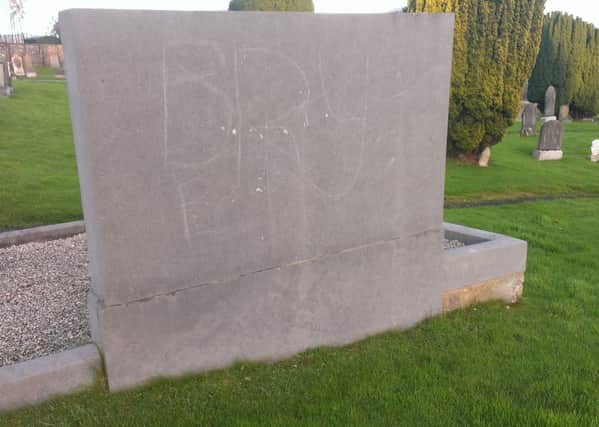War grave desecration a ‘hate crime’


The party hit out at vandals who scrawled a ‘BRY’ slogan - an acronym used by some as shorthand for ‘Bogside Republican Youth’ - on the back of a Commonwealth War Graves Commission memorial in the city cemetery.
DUP Alderman Gary Middleton described the desecration as a hate crime after a visitor to the cemetery - who asked not to be named - contacted the Sentinel to express disappointment the graffiti hadn’t been removed despite the recent centenary commemorations.
Advertisement
Hide AdAdvertisement
Hide Ad“I totally condemn those who have defaced the Commonwealth war memorial in the city cemetery,” said Mr Middleton. “This is a despicable act which can only be seen as a hate crime. Those who carried out this act of vandalism do not represent the majority of people in Londonderry.”


The DUP representative added: “This being the centenary of the outbreak of WW1, there is particular emphasis on remembering those who paid the ultimate sacrifice.
“I would ask those who carried out this attack to reflect on their actions and consider the fact that those we are remembering gave up their todays for our tomorrows.”
A spokesperson for Derry City Council said: “Council was not aware of the damage to the headstone but now it has been brought to our attention we will take action to remove the graffiti.
Advertisement
Hide AdAdvertisement
Hide Ad“I would like to urge members of the public to respect all monuments in the City Cemetery which have been placed out of respect for lost loved ones, as such acts can cause great distress.”
The twelve men died at various times between 1915 and 1919, some of injuries sustained in U-Boat attacks or whilst carrying out minesweeping duties with the Royal Naval Reserve, others of illness, whilst the fates of the rest were unspecified.
According to the grave registration report: Private DN Atkins of the Devonshire Regiment died on September 26, 1918. Colour Sergeant Edward Baker of the Royal Inniskilling Fusiliers died on October 6, 1917; a civilian rigger named A. Bloomfield is said to have died at Rathmullan on July 5, 1918; GT Hammond, second hand on HM Trawler, the Helcia, died on October 11, 1915; Private GF Hayfield of the Dorsetshire Regiment died of pneumonia on October 5, 1919 aged just 19.
Edward Lazenby, a deck hand who served on the HMS Colleen died from pneumonia on October 30, 1916, aged just 20; TH Leask, a stoker on the HMS Anchusa died on February 18, 1918; Henry Lockwood, a trimmer with the Mercantile Marine, who served on the SS Boniface, died on September 1, 1917, from injuries sustained during a U-boat attack; JT Pawley, a stoker, and CS Withey, an Able Seaman, who both served on the HMS Brisk, both died on October 2, 1917; TEJ Powney, who was a stoker on the HMS Poppy, died on August 11, 1917; Private G Shaw, served with the Ayrshire Yeomanry and died of sickness aged 46 on May 1, 1918; and R. Watson, who served as a deckhand on HM Trawler, the Strathlui, died on September 24, 1916.
The Sentinel asked the Commonwealth War Graves Commission (CWGC) for its view of the vandalism and will publish its response once received.